|
 |
 |
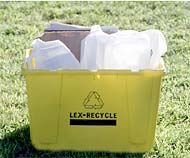 Basic
Facts Basic
Facts
Municipal Solid Waste (MSW)
MSW—more commonly known as trash or garbage—consists of everyday
items such as product packaging, grass clippings, furniture, clothing,
bottles, food scraps, newspapers, appliances, paint, and batteries. To
learn more about MSW, view our interactive presentation about Milestones
in Garbage: 1990–Present.
In 2001, U.S. residents, businesses, and institutions produced
more than 229 million tons 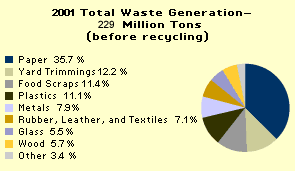 of
MSW, which is approximately 4.4 pounds of waste per person per day, up
from 2.7 pounds per person per day in 1960. of
MSW, which is approximately 4.4 pounds of waste per person per day, up
from 2.7 pounds per person per day in 1960.
Several MSW management practices, such as source reduction, recycling,
and composting, prevent or divert materials from the wastestream. Source
reduction involves altering the design, manufacture, or use of products
and materials to reduce the amount and toxicity of what gets thrown away.
Recycling diverts items, such as paper,
glass, plastic, and metals, from the wastestream. These materials are
sorted, collected, and processed and then manufactured, sold, and bought
as new products. Composting decomposes
organic waste, such as food scraps and yard trimmings, with microorganisms
(mainly bacteria and fungi), producing a humus-like substance.
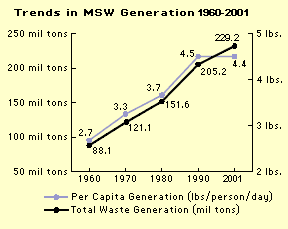
Other practices address those materials that require
disposal. Landfills are engineered
areas where waste is placed into the land. Landfills usually have liner
systems and other safeguards to prevent groundwater contamination. Combustion
is another MSW practice that has helped reduce the amount of landfill
space needed. Combustion facilities burn MSW at a high temperature, reducing
waste volume and generating electricity.
Solid Waste Hierarchy
EPA has ranked the most environmentally sound strategies for MSW. Source
reduction (including reuse) is the most preferred method, followed by
recycling and composting, and, lastly, disposal in combustion facilities
and landfills.
Currently, in the United States, 30 percent is recovered and recycled
or composted, 15 percent is burned at combustion facilities, and the remaining
56 percent is disposed of in landfills.
Source Reduction (Waste Prevention)
Source reduction can be a successful method of reducing waste generation.
Practices such as grasscycling, backyard composting, two-sided copying
of paper, and transport packaging reduction by industry have yielded substantial
benefits through source reduction.
Source reduction has many environmental benefits. It prevents emissions
of many greenhouse gases, reduces pollutants, saves energy, conserves
resources, and reduces the need for new landfills and combustors.
Recycling
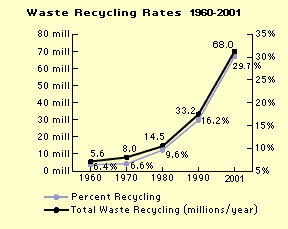 Recycling,
including composting, diverted 68 million tons of
material away from landfills and incinerators in 2001, up from 34 million
tons in 1990. Recycling,
including composting, diverted 68 million tons of
material away from landfills and incinerators in 2001, up from 34 million
tons in 1990.
Typical materials that are recycled include batteries, recycled at a
rate of 94%, paper and paperboard at 45%, and yard trimmings at 57%. These
materials and others may be recycled through curbside programs, drop-off
centers, buy-back programs, and deposit systems.
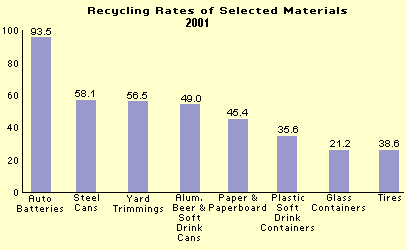
Recycling prevents the emission of many greenhouse gases and water pollutants,
saves energy, supplies valuable raw materials to industry, creates jobs,
stimulates the development of greener technologies, conserves resources
for our childrenís future, and reduces the need for new landfills and
combustors.
Recycling also helps reduce greenhouse gas emissions that affect global
climate. In 1996, recycling of solid waste in the United States prevented
the release of 33 million tons of carbon into the airóroughly the amount
emitted annually by 25 million cars.
Combustion/Incineration
Burning MSW can generate energy while reducing the amount of waste by
up to 90 percent in volume and 75 percent in weight.
EPAís Office of Air and Radiation
is primarily responsible for regulating combustors because air emissions
from combustion pose the greatest environmental concern.
In 2001, in the United States, there were 97 combustors with energy recovery
with the capacity to burn up to 95,000 tons of MSW per day.
Landfills
Under the Resource Conservation and Recovery Act (RCRA), landfills that
accept MSW are primarily regulated by state, tribal, and local governments.
EPA, however, has established national standards these landfills must
meet in order to stay open. Municipal landfills can, however, accept household
hazardous waste.
Resource Conservation and Recovery Act
The Resource Conservation and Recovery Act (RCRA) was enacted by Congress
in 1976 and amended in 1984. The act's primary goal is to protect
human health and the environment from the potential hazards of waste
disposal. In addition, RCRA calls for conservation of energy and natural
resources, reduction in waste generated, and environmentally sound
waste management practices. |
The number of landfills in the United States is steadily decreasing—from
8,000 in 1988 to 1,858 in 2001. The capacity, however, has remained relatively
constant. New landfills are much larger than in the past.
Household Hazardous Waste
Households often discard many common items such as paint, cleaners, oils,
batteries, and pesticides, that contain hazardous components. Leftover
portions of these products are called household
hazardous waste (HHW). These products, if mishandled, can be dangerous
to your health and the environment.
Environmental Terms, Abbreviations, and Acronyms
EPA provides a glossary
that defines in non-technical language commonly used environmental terms
appearing in EPA publications and materials. It also explains abbreviations
and acronyms used throughout EPA.
Recommended Sources for MSW Information
- Background
Press Information On Municipal Solid Waste Management
This series of documents has been organized to assist reporters
covering municipal solid waste management issues. They provide background
information on EPA's solid waste reduction and recycling goals.
- Municipal Solid Waste in the United States:
2001 Facts and Figures: Describes the national MSW stream
based on data collected between 1960 and 2000. Includes information
on MSW generation, recovery, and discard quantities; per capita generation
and discard rates; residential and commercial portions of MSW generation;
and the role of source reduction and other trends in MSW management.
- Decision-Makerís
Guide to Solid Waste Management, Volume II: Contains technical
and economic information to assist solid waste management practitioners
in planning, managing, and operating MSW programs and facilities. Includes
suggestions for best practices when planning or evaluating waste and
recycling collection systems, source reduction and composting programs,
public education, and landfill and combustion issues.
Additional MSW materials can be found at Publications.
Back to top
|

